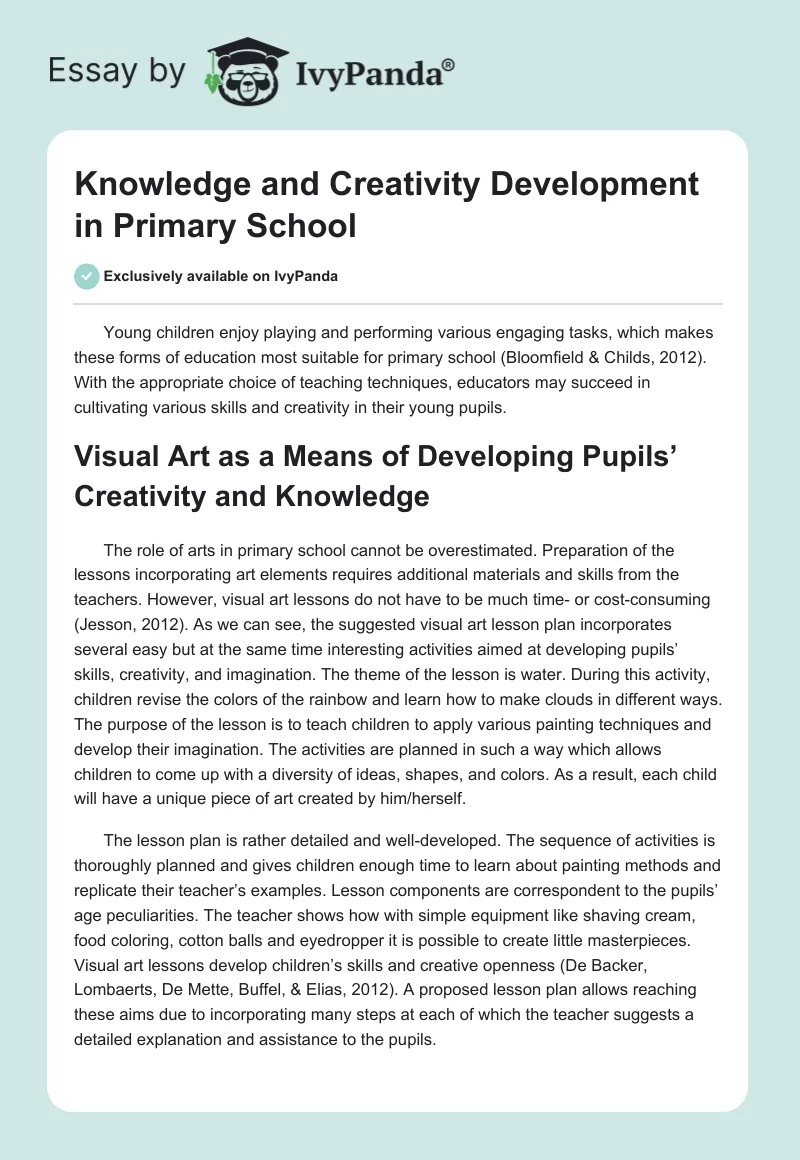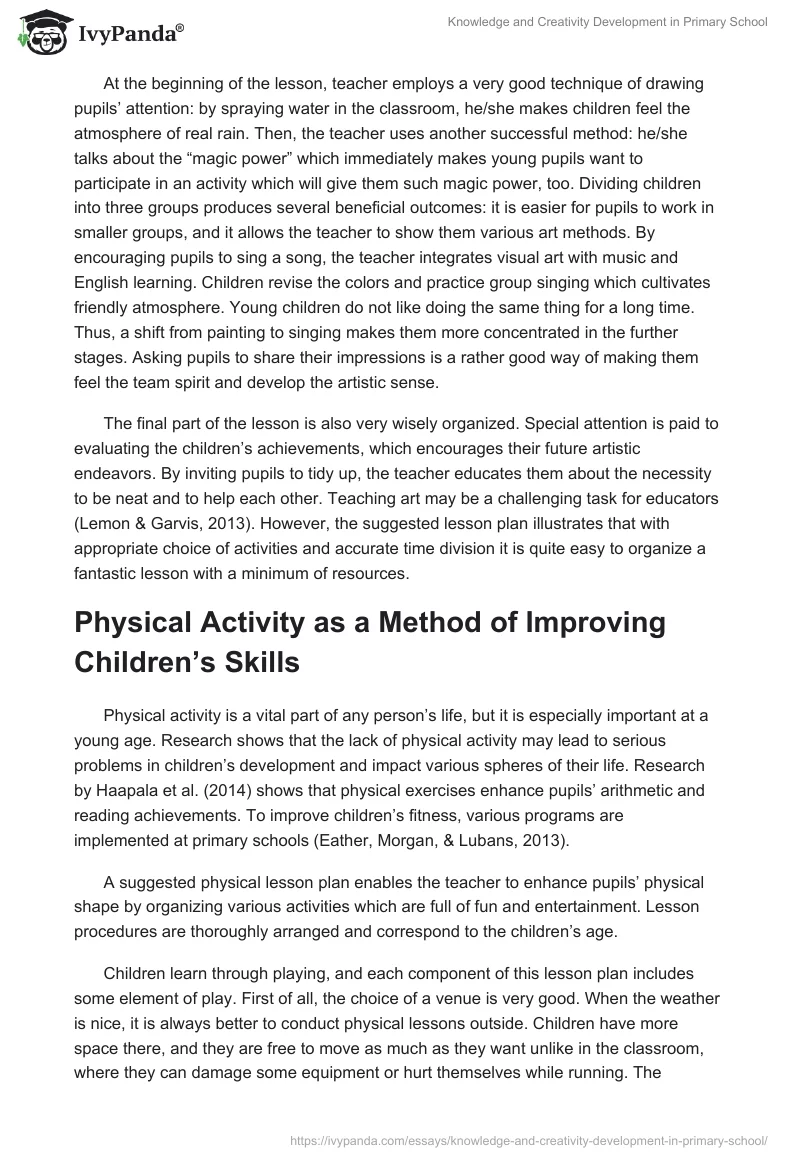Young children enjoy playing and performing various engaging tasks, which makes these forms of education most suitable for primary school (Bloomfield & Childs, 2012). With the appropriate choice of teaching techniques, educators may succeed in cultivating various skills and creativity in their young pupils.
Visual Art as a Means of Developing Pupils’ Creativity and Knowledge
The role of arts in primary school cannot be overestimated. Preparation of the lessons incorporating art elements requires additional materials and skills from the teachers. However, visual art lessons do not have to be much time- or cost-consuming (Jesson, 2012). As we can see, the suggested visual art lesson plan incorporates several easy but at the same time interesting activities aimed at developing pupils’ skills, creativity, and imagination. The theme of the lesson is water. During this activity, children revise the colors of the rainbow and learn how to make clouds in different ways. The purpose of the lesson is to teach children to apply various painting techniques and develop their imagination. The activities are planned in such a way which allows children to come up with a diversity of ideas, shapes, and colors. As a result, each child will have a unique piece of art created by him/herself.
The lesson plan is rather detailed and well-developed. The sequence of activities is thoroughly planned and gives children enough time to learn about painting methods and replicate their teacher’s examples. Lesson components are correspondent to the pupils’ age peculiarities. The teacher shows how with simple equipment like shaving cream, food coloring, cotton balls and eyedropper it is possible to create little masterpieces. Visual art lessons develop children’s skills and creative openness (De Backer, Lombaerts, De Mette, Buffel, & Elias, 2012). A proposed lesson plan allows reaching these aims due to incorporating many steps at each of which the teacher suggests a detailed explanation and assistance to the pupils.
At the beginning of the lesson, teacher employs a very good technique of drawing pupils’ attention: by spraying water in the classroom, he/she makes children feel the atmosphere of real rain. Then, the teacher uses another successful method: he/she talks about the “magic power” which immediately makes young pupils want to participate in an activity which will give them such magic power, too. Dividing children into three groups produces several beneficial outcomes: it is easier for pupils to work in smaller groups, and it allows the teacher to show them various art methods. By encouraging pupils to sing a song, the teacher integrates visual art with music and English learning. Children revise the colors and practice group singing which cultivates friendly atmosphere. Young children do not like doing the same thing for a long time. Thus, a shift from painting to singing makes them more concentrated in the further stages. Asking pupils to share their impressions is a rather good way of making them feel the team spirit and develop the artistic sense.
The final part of the lesson is also very wisely organized. Special attention is paid to evaluating the children’s achievements, which encourages their future artistic endeavors. By inviting pupils to tidy up, the teacher educates them about the necessity to be neat and to help each other. Teaching art may be a challenging task for educators (Lemon & Garvis, 2013). However, the suggested lesson plan illustrates that with appropriate choice of activities and accurate time division it is quite easy to organize a fantastic lesson with a minimum of resources.
Physical Activity as a Method of Improving Children’s Skills
Physical activity is a vital part of any person’s life, but it is especially important at a young age. Research shows that the lack of physical activity may lead to serious problems in children’s development and impact various spheres of their life. Research by Haapala et al. (2014) shows that physical exercises enhance pupils’ arithmetic and reading achievements. To improve children’s fitness, various programs are implemented at primary schools (Eather, Morgan, & Lubans, 2013).
A suggested physical lesson plan enables the teacher to enhance pupils’ physical shape by organizing various activities which are full of fun and entertainment. Lesson procedures are thoroughly arranged and correspond to the children’s age.
Children learn through playing, and each component of this lesson plan includes some element of play. First of all, the choice of a venue is very good. When the weather is nice, it is always better to conduct physical lessons outside. Children have more space there, and they are free to move as much as they want unlike in the classroom, where they can damage some equipment or hurt themselves while running. The beginning of the lesson is rather well-planned: the teacher introduces the theme by spraying some water and inviting the pupils to imagine that it is raining. Then, by a series of questions the teacher stimulates the children to explain what happens when it rains and how people protect from getting wet. At this stage, we can see the integration of physical lesson with ethics when pupils are asked to shelter their friends from rain.
Another way of integration is when pupils are invited to sing a song. They practice vocabulary on the theme “transport” and memorize the use of the phrase “let’s.” Additionally, their music skills are enhanced.
The plan enables the teacher to train various skills in pupils. By inviting children to crawl through the tunnel to get the necessary equipment, a teacher develops children’s gross motor skills. By asking them to walk on a balancing beam, teacher trains the pupils’ coordination, attention, and balance. Dividing pupils into three groups is an advantageous idea as it allows organizing each activity better and also enables the pupils to remember who belongs to their team.
Another benefit of this lesson plan is that it develops not only creative but also logical thinking. Pupils need to choose the most appropriate equipment to wash the car. Also, they are invited to analyze their choice and contemplate on the outcomes of their activity. The final part of the lesson contains such vital elements as assessment and discussion of the achievements, which is rather encouraging for young children. The lesson plan incorporates all the necessary elements, and its implementation will lead to the development of pupils’ skills and creativity.
Conclusion
Primary school plays a vital role in the formation of the pupils’ skills. Teachers should pay special attention to the activities which enhance creative thinking and knowledge of the pupils. Suggested lesson plans are great examples of how a teacher can engage primary school pupils in educational activities which produce a beneficial effect. By integrating the elements from different subjects, a teacher can enrich the lesson and increase the children’s achievements.
References
Bloomfield, A., & Childs, J. (2012). Teaching integrated arts in the primary school: Dance, drama, music, and the visual arts (2nd ed.). New York, NY: Routledge.
De Backer, F., Lombaerts, K., De Mette, T., Buffel, T., & Elias, W. (2012). Creativity in artistic education: Introducing artists into primary schools. International Journal of Art & Design Education, 31(1), 53-66.
Eather, N., Morgan, P. J., & Lubans, D. R. (2013). Improving the fitness and physical activity levels of primary school children: Results of the fit-4-fun group randomized controlled trial. Preventive Medicine, 56(1), 12-19.
Haapala, E. A., Poikkeus, A.-M., Kukkonen-Harjula, K., Tompuri, T., Lintu, N., Väistö, J.,… Lakka, T. A. (2014). Associations of physical activity and sedentary behavior with academic skills – A follow-up study among primary school children. PLoS ONE, 9(9), 1-12.
Jesson, J. (2012). Developing creativity in the primary school. New York, NY: Open University Press.
Lemon, N., & Garvis, S. (2013). What is the role of the arts in a primary school?: An investigation of perceptions of pre-service teachers in Australia. Australian Journal of Teacher Education, 38(9), 1-9.


